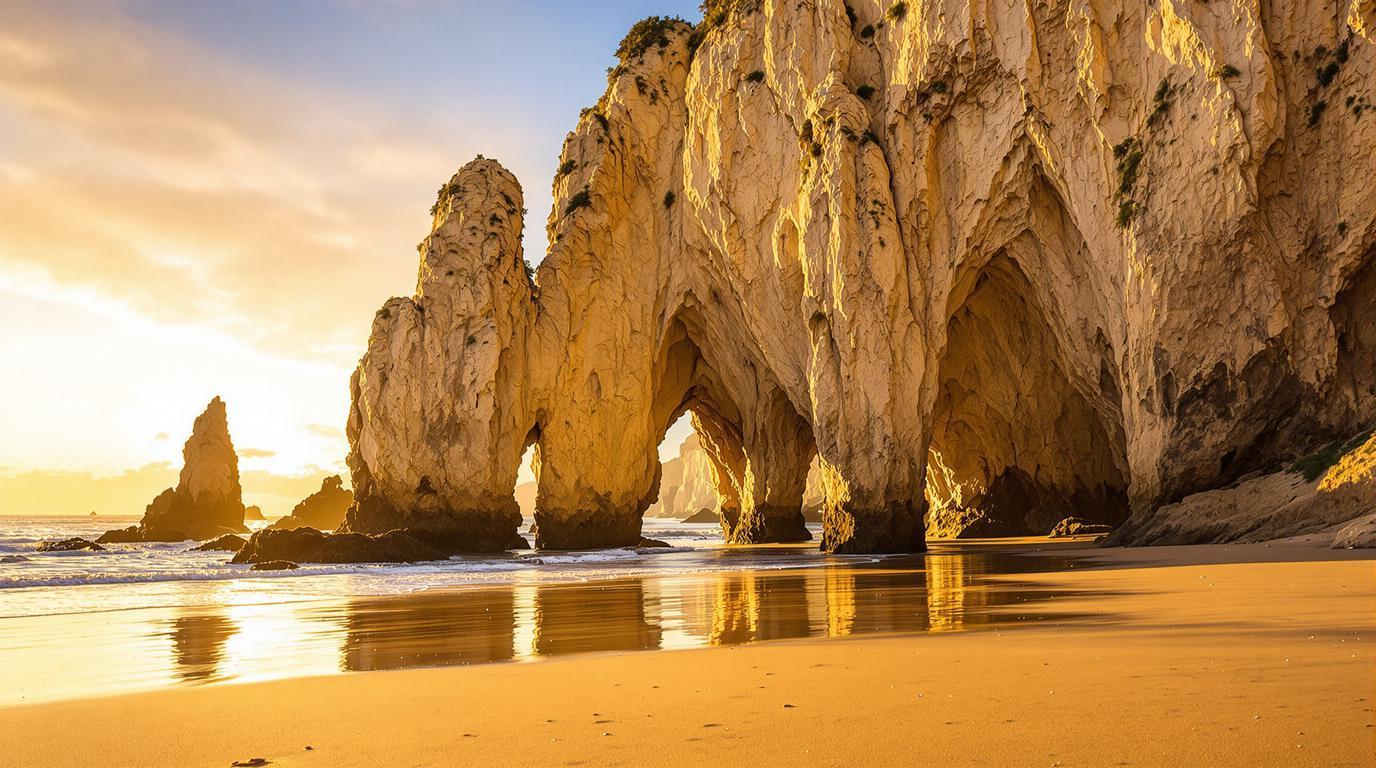Standing on the rugged Galician coast, I watched the Atlantic tide retreat to reveal something extraordinary. This tiny 800-meter stretch of Spanish coastline transforms into a natural Gothic cathedral, complete with towering stone arches that rise 30 meters from the sand. What locals call “Praia de Augas Santas” – the Beach of Holy Waters – defies every expectation of what a small beach can contain.
The numbers seem impossible. How can a beach smaller than eight football fields house stone cathedrals taller than ten-story buildings? Yet here, where the Cantabrian Sea meets ancient slate cliffs, geological forces have carved what appears to be humanity’s greatest architectural achievement – except nature built these flying buttresses millions of years ago.
This is Playa de las Catedrales, and despite its fame among Spanish travelers, it remains a protected secret that most international visitors never discover. The Galician government limits access to just 4,800 people daily, making advance reservations essential for summer visits.
The scale that transforms everything
Tiny dimensions with monumental impact
Walking this compact coastline feels like discovering a hidden world. The beach stretches just 800 meters from end to end, yet contains more natural architecture than most cities. During low tide, Gothic arches reveal themselves as cathedral-like passages you can walk through, their ceilings disappearing into darkness above.
Measurements that defy logic
The largest arch soars 90 feet high – equivalent to a nine-story building rising directly from the sand. Stone tunnels extend 30 meters deep into the cliff face, creating natural naves and transepts that rival any human cathedral. This tiny beach contains more vertical drama per square meter than anywhere else on Spain’s coast.
The tide-dependent magic locals protect
Holy waters that reveal and conceal
Locals named this place “Praia de Augas Santas” long before tourists arrived, recognizing something sacred in waters that dramatically reveal and hide these formations twice daily. High tide transforms the beach into a standard Atlantic coastline. Low tide unveils the cathedral arches, creating a pilgrimage site that exists only four hours per day.
The reservation system that preserves wonder
Galician authorities protect this tiny treasure through mandatory free reservations during peak season. With only 4,800 daily slots available, roughly one-third of nearby Ribadeo’s population could visit simultaneously. This controlled access ensures the intimate scale remains unspoiled by mass tourism.
What guidebooks miss about authentic Galicia
Celtic-Atlantic heritage beyond the arches
This coastline represents Celtic Galicia’s spiritual connection to the Atlantic. Local fishing communities have revered these formations for generations, viewing them as natural temples where land meets sea. The Gothic comparison isn’t coincidental – medieval builders drew inspiration from natural forms like these when designing Europe’s great cathedrals.
The geological story spanning millions of years
These aren’t sandstone formations that crumble easily. Slate and schist cliffs, among the hardest rocks in Spain, required millions of years of Atlantic storms to carve these precise architectural forms. Each arch represents geological time scales that dwarf human cathedral-building efforts, making this tiny beach a monument to Earth’s patient artistry.
The authentic experience mass tourism can’t touch
Summer timing that rewards the prepared
July 2025 brings warm 25°C air temperatures and refreshing 18°C Atlantic waters perfect for exploring tide pools between cathedral arches. Summer’s long daylight hours mean low tide often coincides with golden hour lighting, creating photographic opportunities that rival Portugal’s hidden coastal gems.
The cultural protection that keeps it special
Unlike Spain’s overdeveloped Mediterranean beaches, this Natural Monument status ensures development remains minimal. Local restaurants in Ribadeo serve traditional Galician seafood, and the only sounds are Atlantic waves and seabirds – no beach clubs or jet skis disturb the cathedral-like serenity that makes this tiny beach feel infinite.
Planning your cathedral pilgrimage
How do I make reservations for Playa de las Catedrales?
Book free reservations at ascatedrais.xunta.es up to 30 days in advance. Summer slots fill quickly, so reserve immediately upon deciding your travel dates. No reservations needed outside Easter and summer months.
What’s the best time to visit the cathedral arches?
Visit during low tide for full access to arches and caves. Check tide charts before traveling – high tide makes the formations inaccessible. Early morning and late afternoon provide the best lighting for photography.
Can you swim at this beach?
Swimming is safest during high tide when waves are calmer. The beach offers protected swimming areas, but the real attraction is exploring the revealed cathedral architecture during low tide periods.
This tiny Galician beach proves that Spain’s most extraordinary experiences often come in the smallest packages. Where else can you walk through 30-meter stone cathedrals that exist only when the Atlantic decides to reveal them? Book your pilgrimage to these holy waters and discover why locals guard this natural cathedral so carefully.
